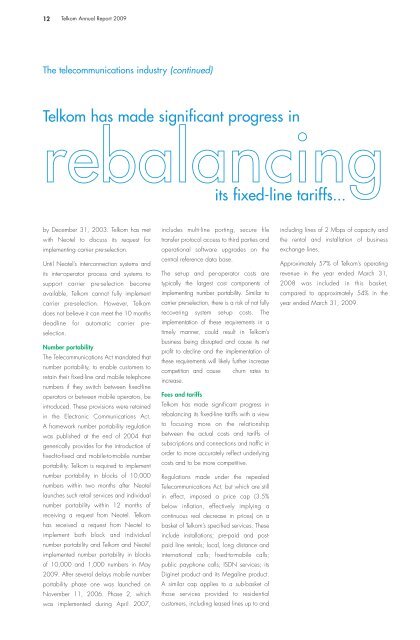Telkom AR front.qxp
Telkom AR front.qxp
Telkom AR front.qxp
Create successful ePaper yourself
Turn your PDF publications into a flip-book with our unique Google optimized e-Paper software.
12<br />
<strong>Telkom</strong> Annual Report 2009<br />
The telecommunications industry (continued)<br />
<strong>Telkom</strong> has made significant progress in<br />
rebalancing<br />
its fixed-line tariffs...<br />
by December 31, 2003. <strong>Telkom</strong> has met<br />
with Neotel to discuss its request for<br />
implementing carrier pre-selection.<br />
Until Neotel’s interconnection systems and<br />
its inter-operator process and systems to<br />
support carrier pre-selection become<br />
available, <strong>Telkom</strong> cannot fully implement<br />
carrier pre-selection. However, <strong>Telkom</strong><br />
does not believe it can meet the 10 months<br />
deadline for automatic carrier preselection.<br />
Number portability<br />
The Telecommunications Act mandated that<br />
number portability, to enable customers to<br />
retain their fixed-line and mobile telephone<br />
numbers if they switch between fixed-line<br />
operators or between mobile operators, be<br />
introduced. These provisions were retained<br />
in the Electronic Communications Act.<br />
A framework number portability regulation<br />
was published at the end of 2004 that<br />
generically provides for the introduction of<br />
fixed-to-fixed and mobile-to-mobile number<br />
portability. <strong>Telkom</strong> is required to implement<br />
number portability in blocks of 10,000<br />
numbers within two months after Neotel<br />
launches such retail services and individual<br />
number portability within 12 months of<br />
receiving a request from Neotel. <strong>Telkom</strong><br />
has received a request from Neotel to<br />
implement both block and individual<br />
number portability and <strong>Telkom</strong> and Neotel<br />
implemented number portability in blocks<br />
of 10,000 and 1,000 numbers in May<br />
2009. After several delays mobile number<br />
portability phase one was launched on<br />
November 11, 2006. Phase 2, which<br />
was implemented during April 2007,<br />
includes multi-line porting, secure file<br />
transfer protocol access to third parties and<br />
operational software upgrades on the<br />
central reference data base.<br />
The set-up and per-operator costs are<br />
typically the largest cost components of<br />
implementing number portability. Similar to<br />
carrier pre-selection, there is a risk of not fully<br />
recovering system set-up costs. The<br />
implementation of these requirements in a<br />
timely manner, could result in <strong>Telkom</strong>’s<br />
business being disrupted and cause its net<br />
profit to decline and the implementation of<br />
these requirements will likely further increase<br />
competition and cause churn rates to<br />
increase.<br />
Fees and tariffs<br />
<strong>Telkom</strong> has made significant progress in<br />
rebalancing its fixed-line tariffs with a view<br />
to focusing more on the relationship<br />
between the actual costs and tariffs of<br />
subscriptions and connections and traffic in<br />
order to more accurately reflect underlying<br />
costs and to be more competitive.<br />
Regulations made under the repealed<br />
Telecommunications Act, but which are still<br />
in effect, imposed a price cap (3.5%<br />
below inflation, effectively implying a<br />
continuous real decrease in prices) on a<br />
basket of <strong>Telkom</strong>’s specified services. These<br />
include installations; pre-paid and postpaid<br />
line rentals; local, long distance and<br />
international calls; fixed-to-mobile calls;<br />
public payphone calls; ISDN services; its<br />
Diginet product and its Megaline product.<br />
A similar cap applies to a sub-basket of<br />
those services provided to residential<br />
customers, including leased lines up to and<br />
including lines of 2 Mbps of capacity and<br />
the rental and installation of business<br />
exchange lines.<br />
Approximately 57% of <strong>Telkom</strong>’s operating<br />
revenue in the year ended March 31,<br />
2008 was included in this basket,<br />
compared to approximately 54% in the<br />
year ended March 31, 2009.




